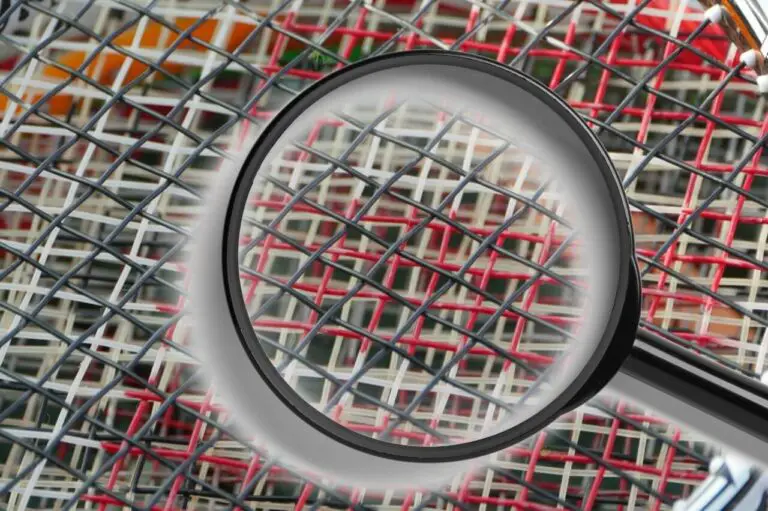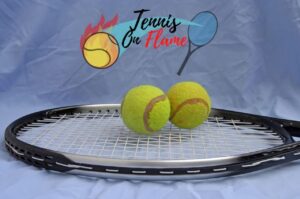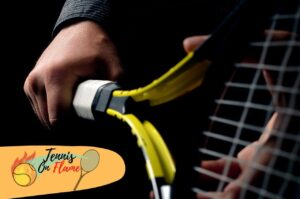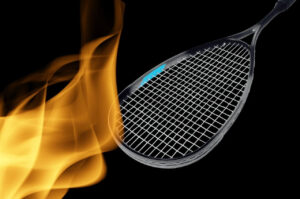The strings on a tennis racket are made of different materials – each having its own advantages and disadvantages.
If you’re curious about what materials tennis racket strings are made of, you’ve come to the right place.
In this article, we’ll explore the different materials that can be used to make strings for a tennis racket.
We’ll also take a look at some of the benefits and drawbacks of each material.
So, whether you’re a beginner just getting started in the sport or an experienced player looking to upgrade your equipment, read on for all the information you need!
Let’s start!
So what are the strings on a tennis racket made of?
There are five main types of strings for tennis rackets:
Synthetic gut
Nylon is the most frequent material used to make synthetic gut.
It’s a very inexpensive string to produce and is the cheapest of all strings to purchase.
Multi-filament
These strings are also made of nylon, but they’re composed of multiple filaments.
They’re typically more expensive than synthetic gut strings, but they hold tension more effectively, are more elastic, and generate greater power.
Multi-filament strings are the next most expensive, followed by Natural Gut.
Natural gut
These strings are made from cow intestines. They’re the most expensive type of string available, Gut strings, as opposed to synthetic ones, will keep their tension for a longer period and “feel” more excellent for a much greater length of time.
Polyester
These are Synthetic tennis strings.
Polyester is quite popular among intermediate to advanced tennis players.
It offers excellent topspin, control, durability, and low power.
Hybrid
These strings are made by combining two different types of strings.
The most common combination is polyester with gut or synthetic gut. This combination offers the benefits of both types of strings.

How often do I need to change my tennis racket strings?
The strings of your tennis racket need regularly replacing, especially if you play every day.
The rule of thumb is that if you are changing the strings for better performance, you must do so as frequently as you play per week, every year.
Strings become worn out much faster than other parts of the racket that can last longer.
How do you know when to replace your tennis racket strings?
You can tell if your tennis rackets strings have reached the end of their life by these signs:
-The strings are comings apart.
-The ball is not as lively as when you used new strings on your racket.
-At contact, the strings produce a “thud” sound.
-The feel and control are affected, so the accuracy is reduced.
-If you hit the ball with your racket, but it does not bounce back.
-Strings are considerably bent than usual after points.
What tension is best for a tennis racket?
The common string tension of a tennis racket is usually between 48 lbs to 54 lbs.
String tension is very important for the performance of a tennis racket. If the tension is loose, you will have greater power over it. If the tension is tight, you will have greater control.
Beginners will want a greater degree of control, so they’ll choose the string tension to be tighter.
If you are not sure what tension to use, you can always ask your trusted tennis professional for help. They can guide you to the perfect string tension depending on your playing level and style.
What string tension do pros use?
Pro tennis players often use string tensions that are much higher than what recreational players use.
They are using between 40 lbs to 65 lbs, This is because they hit the ball harder and with more topspin, which puts more strain on the strings.
As a result, their strings break much more frequently, so they need to replace them more often. They also need to be very careful about their string tension, as a few extra pounds of pressure can make a big difference in their performance.
What is the Tennis string gauges range?
When it’s come to string gauges, The lower the string gauge number (15), the thicker the string. The higher the string gauge number(19), the thinner the string.
There are also half-gauges indicated with an L (15L, 16L, etc).
What string do most pros use?
The string that most pros are using is polyester.
Polyester strings offer excellent topspin, control, durability, and low power.
What tennis string do most beginners and intermediate players use?
Most beginners use nylon or natural gut string.
Beginner to intermediate players will find nylon and natural gut strings generate more power and are more comfortable.
In conclusion:
There are five main types of strings for tennis rackets: Synthetic gut, Multi-filament, Natural gut, Polyester, and Hybrid.
The rule of thumb is that if you are changing the strings for better performance, you must do so as frequently as you play per week, every year.
You can tell if your tennis racket strings have reached the end of their life by these signs:
The strings are coming apart, the ball is not as lively as when you used new strings on your racket, at contact the strings produce a “thud” sound, and the feel and control are affected, so the accuracy is reduced (other signs in this guide above).
The common string tension is usually between 48 lbs to 54 lbs.
Pro tennis players often use string tensions that are much higher than what recreational players use (between 40 lbs to 65 lbs).
When it’s come to string gauges, The lower the string gauge number (15), the thicker the string. The higher the string gauge number(19), the thinner the string.
The string that most pros are using is polyester. Polyester strings offer excellent topspin, control, durability, and low power.
The type of string you choose will depend on your skill level, playing style, and desired performance.
If you are a beginner, you may want to use nylon or natural gut strings. If you are an intermediate or advanced player, you may want to use polyester strings.
Ultimately, the best way to find the perfect string for you is to experiment with different types and see what works best for your game.
I hope this article helped you learn about: What are the strings on a tennis racket made of?
If you have any further questions, please feel free to leave a comment below. 🙂
And be sure to check out my other blog posts for more informative guides.
Thanks for reading, and I hope you will find the perfect strings for your need!








